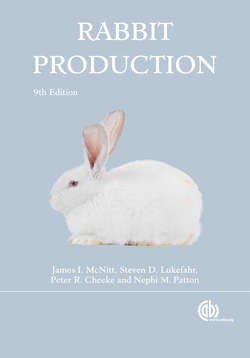Читать книгу Rabbit Production - James I McNitt - Страница 15
На сайте Литреса книга снята с продажи.
Sources of Helpful Information
ОглавлениеFor many years, the United States Department of Agriculture (USDA) maintained the U.S. Rabbit Experiment Station at Fontana, California (Fig. 1.11). This station was the source of much useful information on rabbit production. The station was closed when it appeared that rabbit production was not going to become a major agricultural enterprise in the United States. Rabbit research was at very low ebb in the 1960s and early 1970s. Since that time, interest in the rabbit as a meat animal has been rekindled, due in part to the increasing awareness of the competition between livestock and humans for grain. A major program of rabbit research was established at Oregon State University’s Rabbit Research Center. The Research Center published The Journal of Applied Rabbit Research, which contained reports of the latest research on commercial rabbit production. This unit has now been closed, but the rabbit research program at Texas A&M University-Kingsville is still functioning. Most of the land-grant universities, through their extension departments, sponsor 4-H rabbit club activities in their respective states, and several have sponsored rabbit schools. These schools are similar to the forums or courses that for many years have been conducted for other types of farm animals. They have been extremely valuable to the rabbit industry, with members of the university faculty and other well-informed representatives of the rabbit industry participating. One of the most valuable features of these rabbit school programs is the time allotted to questions and answers.
Fig. 1.11. The former US Rabbit Experiment Station at Fontana, California, where Mr. George Templeton served as Director for many years. (Courtesy of P.R. Cheeke)
Some of the state agricultural universities issue bulletins on rabbit production and assign a member of the extension department to the specific duty of assisting the industry in the state. Advice may also be obtained by contacting agricultural agents and farm advisors. The Internet is a good source of rabbit information and a method to make contact with experienced breeders.
The American Rabbit Breeders Association, Inc. (ARBA), P.O. Box 5667, Bloomington, IL 61702, addresses many aspects of the rabbit industry, but an overwhelming majority of the members are fanciers, so the primary focus of the organization is on the fancy. The ARBA assists rabbit fanciers in many ways by maintaining a registration and recording system, providing memberships to persons interested in breeding and marketing rabbits and allied products, promoting and conducting public and private exhibitions, providing judging systems, licensing official judges and registrars, making and revising official standards and maintaining a web site at www.ARBA.net. A magazine, Domestic Rabbits, is also published every other month. The association also organizes and assists local, county, and state associations and specialty clubs, maintains information bureaus, and furnishes at cost bulletins, guide books, and other printed matter. It helps in marketing and in securing legislation and publicity. An annual convention and show are held.
Contact with members of local rabbit clubs is an excellent means for beginners to obtain information relative to rabbit production, such as facts on cooperative buying and marketing of products, lists of reliable breeders, ordinances with relation to the industry, etc.
There is increasing interest in rabbits as pets. As described in Chapter 18, the housing, nutritional, and social needs of companion rabbits differ in several key aspects from those of production or show animals. An excellent resource for pet rabbit information is the House Rabbit Society, 148 Broadway, Richmond, CA, 94804-1912. The HRS maintains a website (www.rabbit.org) and publishes the quarterly House Rabbit Newsletter.
Some feed manufacturers have spent a great deal of time and money in research work to develop efficient rations for rabbits. They also issue bulletins and sometimes furnish the breeder with hutch cards and other record cards. Many of them have field representatives who make visits to rabbitries and assist the breeders with their rabbit problems. Some large feed companies have their own research and testing facilities.
A wealth of information about rabbits can be found on the Internet. Using a search engine to locate the sites for the World Rabbit Science Association (WRSA), the ARBA, or the HRS will provide much useful information as well as links to other sites.
